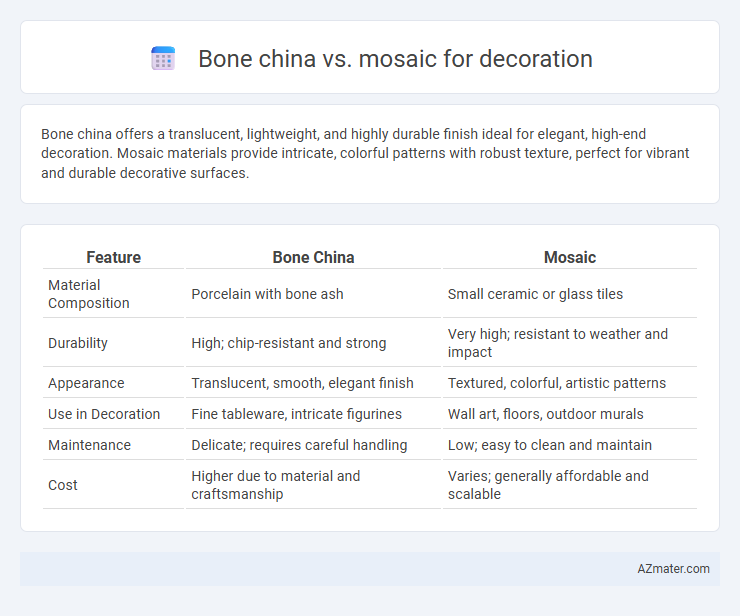Bone china offers a translucent, lightweight, and highly durable finish ideal for elegant, high-end decoration. Mosaic materials provide intricate, colorful patterns with robust texture, perfect for vibrant and durable decorative surfaces.
Table of Comparison
| Feature | Bone China | Mosaic |
|---|---|---|
| Material Composition | Porcelain with bone ash | Small ceramic or glass tiles |
| Durability | High; chip-resistant and strong | Very high; resistant to weather and impact |
| Appearance | Translucent, smooth, elegant finish | Textured, colorful, artistic patterns |
| Use in Decoration | Fine tableware, intricate figurines | Wall art, floors, outdoor murals |
| Maintenance | Delicate; requires careful handling | Low; easy to clean and maintain |
| Cost | Higher due to material and craftsmanship | Varies; generally affordable and scalable |
Understanding Bone China: Features and Benefits
Bone china is a type of porcelain known for its high levels of whiteness, translucency, and chip resistance, achieved by incorporating bone ash into the ceramic mix. This unique composition provides exceptional strength and durability while maintaining a delicate, elegant appearance, ideal for fine decoration purposes. Its smooth, glossy surface enhances intricate designs and vibrant colors, making bone china a preferred choice for luxurious decorative items and high-end tableware.
What is Mosaic? An Overview
Mosaic is an ancient decorative art form that involves assembling small pieces of colored glass, stone, or ceramic, called tesserae, to create intricate patterns or images on surfaces such as walls, floors, and furniture. Unlike bone china, which is a type of fine porcelain known for its translucency and delicate appearance, mosaics emphasize texture, durability, and vibrant visual storytelling through geometric or figurative designs. Mosaics offer a versatile and enduring option for decoration, particularly in architectural and artistic contexts where bold visual impact and structural resilience are essential.
Aesthetic Appeal: Bone China vs Mosaic
Bone china offers a smooth, translucent finish with a refined, elegant appearance ideal for sophisticated decorative settings. Mosaic art provides vibrant, textured patterns that create dynamic visual interest through the use of varied colors and materials. The aesthetic appeal of bone china emphasizes luxury and delicacy, while mosaics showcase bold creativity and intricate craftsmanship.
Durability and Longevity: Which Lasts Longer?
Bone china is renowned for its exceptional durability and resistance to chipping, making it a preferred choice for long-lasting decorative pieces. Mosaic decorations, often made from glass, ceramic, or stone, offer strong durability but can be prone to grout cracking and tile loosening over time. Bone china typically lasts longer in indoor decorative settings due to its fine composition and resilience against wear and tear compared to mosaic materials.
Installation Process: Ease and Requirements
Bone china decorations require careful handling during installation due to their delicate and brittle nature, often necessitating skilled professionals and specialized adhesives to prevent damage. Mosaic decoration installation involves placing small pieces of tile or glass on a prepared surface, allowing for more flexibility and easier repair if pieces break, typically requiring standard tile adhesive and grout. While bone china demands precision and gentleness, mosaic installations offer a more forgiving and straightforward process suitable for various surfaces.
Design Versatility: Patterns and Colors
Bone china offers exceptional design versatility with its smooth, translucent surface allowing for intricate, detailed patterns and vibrant colors that maintain clarity and elegance. Mosaic decoration excels in creating dynamic, textured designs using small, differently colored tiles that can form complex geometric or abstract patterns, providing a tactile and visually striking effect. The choice between bone china and mosaic depends on whether the desired aesthetic emphasizes delicate, refined artwork or bold, three-dimensional visual impact.
Maintenance and Cleaning Comparison
Bone china offers superior durability and resistance to chipping, making maintenance easier through simple hand washing with mild detergent and warm water, avoiding abrasive scrubbing. Mosaic decorations, often made from glass or ceramic tiles, require more meticulous care to preserve grout integrity and prevent discoloration; regular sealing and gentle cleaning with non-acidic cleaners are essential. Both materials benefit from prompt cleaning to avoid stains, but bone china demands less frequent deep maintenance compared to mosaic surfaces.
Cost Analysis: Bone China vs Mosaic
Bone china typically incurs higher upfront costs due to premium raw materials like kaolin, feldspar, and petuntse, along with intricate manufacturing processes requiring skilled artisans and longer firing times. Mosaic decoration presents a more cost-effective alternative, utilizing affordable materials such as ceramics, glass, and stone pieces that can be mass-produced and assembled with less specialized labor. Over time, bone china's durability and classic aesthetic may justify its initial expense for luxury decor, while mosaics offer versatile design options at lower installation and maintenance costs, making them ideal for budget-conscious projects.
Environmental Impact and Sustainability
Bone china production involves calcined animal bones combined with porcelain clay, resulting in a refined, durable material but raising concerns about animal product sourcing and energy-intensive firing processes. Mosaic tiles, typically made from recycled glass, ceramics, or natural stones, offer an eco-friendly alternative with lower raw material impact and often incorporate sustainable recycling practices. Choosing mosaics can reduce environmental footprint through use of recycled content and less energy consumption, whereas bone china's sustainability hinges on ethical bone sourcing and advances in manufacturing efficiency.
Best Uses for Bone China and Mosaic in Decoration
Bone china offers a translucent, elegant finish ideal for fine tableware, decorative vases, and intricate figurines that require a delicate, high-end appearance. Mosaic excels in creating vibrant, textured surfaces perfect for wall art, tabletops, and outdoor installations where durability and visual impact are crucial. Choosing bone china enhances refined indoor decor with its smooth, glossy surface, while mosaic adds colorful, tactile dimension suited for both indoor and outdoor decorative applications.

Infographic: Bone china vs Mosaic for Decoration
 azmater.com
azmater.com